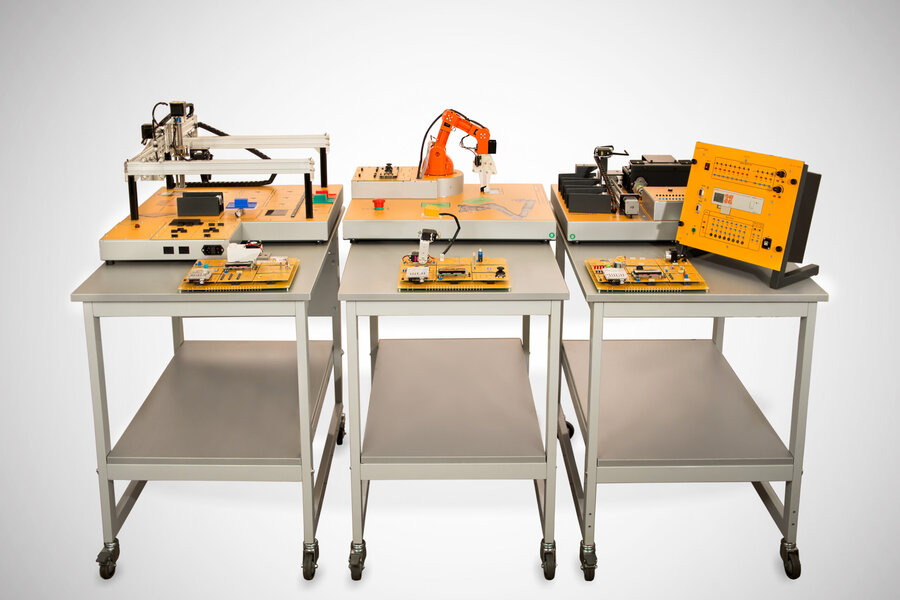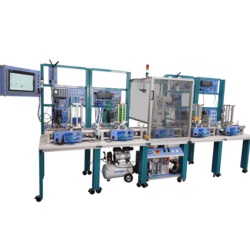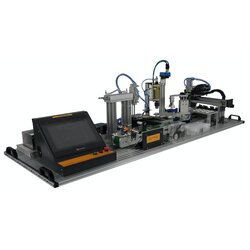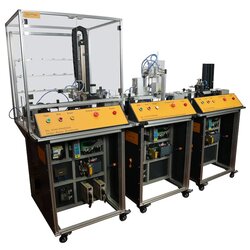Equipment System For The Study Of Industry 4.0 “Smart Factory” Enhanced With Artificial Intelligence (DL I4.0 FACTORY-AI)


PL-721838
Industry 4.0 (I4.0) and Artificial Intelligence (AI) are revolutionizing the manufacturing sector by integrating advanced technologies to create "smart factories”.
The digitization of information, combined with high-performance hardware and AI technologies, enables the implementation of more flexible and optimized production architectures. The level of innovation is such that today, Industry 4.0 is synonymous with intelligent manufacturing, and the adjective "smart" refers to integrated information management, enhanced by AI and digital technology.
This proposed educational system reproduces a collaborative environment to study concepts related to Industry 4.0 enhanced with AI, integrating small-scale subsystems commonly found in a manufacturing plant. It is composed of a set of electronic boards, real hardware simulators and software to study the different subsystems that can be found in a real production line. The students, using an open-source microcontroller connected to SCADA (Supervisory Control And Data Acquisition) software for data acquisition, will be able to perform activities covering topics on introduction to automation and robotics, communication protocols (IoT), sensors and actuators and complete study of a productive system related to Industry 4.0.
The added DL AI-MODULE to this system uses the SCADA data to enhance operational efficiency across key areas. It predicts equipment failures with predictive maintenance, detects real-time anomalies, optimizes production processes, automates quality control, forecasts energy consumption, and improves supply chain management.
In today’s rapidly evolving industrial landscape, leveraging data to enhance operational efficiency and predict potential issues is crucial for maintaining competitive advantage. The DL AI-MODULE focuses on the application of advanced data analytics and artificial intelligence (AI) to optimize various aspects of production and operational processes. By analyzing historical and real -time data, the module helps organizations reduce costs, minimize waste, and maintain high performance.
DL 3155BRS-RFID - RFID protocol study board
This board allows to study the properties of an RFID system and all components necessary to develop a door access control system. The students can interact with the hardware in a simple way through software explaining step-by-step the operation of the system. The integration of the RFID elements in an industrial process is possible using a SCADA software for the study of automation and industry 4.0 concepts. This base board includes built-in power supply, providing all the voltages necessary for its operation, with the following circuit mini boards: real time clock, LCD display, RFID reader/writer, transponder, audio speaker, relay, tag receiver, keyboard, microcontroller.
The students can perform the following activities:
- Behaviour of the reader when a tag is identified.
- How to read data from proximity integrated circuit card using a RFID reader.
- How to read and write data blocks on a MIFARE proximity integrated circuit card.
- How to write and how to read personal data to a MIFARE proximity integrated circuit card using an RFID reader.
- How to activate a relay using the outputs of the microcontroller.
- How to control a display and a real time clock by using the microcontroller.
- How to connect a keypad to a microcontroller.
- Simulation of a door access control system.
DL ROB-SIM - Kit for the study of a robotic arm
Consisting of simulator and electronic boards, for the study of the properties and control techniques of a 5-axis robotic arm used in industrial environments. They include sensors and actuators so as to develop a complete course on robot control systems. The students can interact with the hardware in a simple way through software explaining step-by-step the operation of the system.
It is composed of the following:
- Collection of boards to study the hardware characteristics and the control techniques of a robotic system through an open-source microcontroller. The sub-boards include all the components, sensors and actuators needed to develop an educational robotic arm. It includes a base board with built-in power supply, providing all the voltages necessary for its operation with the following circuit mini boards: joystick, LCD display, servo-motor, ultrasonic sensor, flex sensor, gyroscope, Bluetooth, microcontroller.
The students can perform the following activities:
-
- Characteristics of a joystick controller and interface with the microcontroller.
- Study of a servomotor and its controller.
- Introduction to the Bluetooth standard and implementation of a Bluetooth interface with the microcontroller.
- Analysis of a flex sensor and its interfacing with the microcontroller.
- Study of an ultrasonic proximity sensor.
- How to control an LCD display through I2C communication interface.
- How to measure orientation and angular velocity using a gyroscope.
- Basic control techniques: controlling a servo using a joystick and displaying servo position on an LCD display.
- Real hardware simulator of a 5-axis robotic arm used in an industrial environment to learn how to operate a robotic arm through a programmed microcontroller. It allows the connection with the board kit components, making them compatible with each other.
It has the following technical characteristics:
-
- Power supply: 90V-230V ±10%, 50/60Hz.
- Angle/distance range: 1° axis: 180°, 2° axis: 180°, 3° axis: 180°, 4° axis: 180°, 5° axis: 180°, 6° axis: gripper opening (max. 55 mm).
- Servo specifications: dimensions (approx.): 40 x 18 x 40 mm, operating speed (approx.): 0,17 ÷ 0,13sec / 60 grades (4,8 ÷ 6,0 V with no load), stall torque (approx.): 13 ÷ 15 kg-cm a 4,8/6 V, operating voltage: 4,8 ÷ 7,2V.
- Compatible with Arduino UNO boards, indicatively ATmega328 processor, 32KB flash memory, 1KB EEPROM memory, 2KB SRAM memory, 23 general purpose I/O ports.
- RFID detector.
- Interfacing with SCADA monitoring software.
The students can perform the following activities:
-
- Study of the robot components.
- Arm control in real time using a joystick.
- Step-by-step movement programming.
- Movements recording.
- Controlling position using a gyroscope.
- Bluetooth communication for remote control.
DL CIM-SIM - Kit for the study of a conveyor belt
Consisting of simulator and electronic boards, for the study of the properties and operation of a conveyor belt used in industrial environments. They include sensors and actuators so as to develop a complete course on main features of conveyor systems and its applications. The students can interact with the hardware in a simple way through software explaining step-by-step the operation of the system.
It is composed of the following:
- Collection of boards to study the hardware characteristics and the control techniques of a conveyor belt. The sub-boards include all the components, sensors and actuators needed to understand and manage the operation of a conveyor belt. It includes a base board with built-in power supply, providing all the voltages necessary for its operation, with the following circuit mini boards: LCD display, DC driver motor, DC motor, BRS inputs, seven segment, stepper motor, IRD sensor, RGB sensor, microcontroller.
The students can perform the following activities:
-
- How to control an LCD display through a microcontroller.
- Monitoring an infrared positioning system and of a RGB sensor.
- How to control a DC motor through a power driver - a stepper motor - a seven segment LCD display.
- Real hardware simulator of a conveyor belt unit used in a real industrial environment to learn how to operate and to control production line by using a PLC (included in the system) and an open-source microcontroller.
The students can perform the following activities:
-
- How to control a conveyor belt through a push button panel.
- Using a PLC to control the conveyor belt movement.
- How to control and identify a processed item on the conveyor belt.
- How to monitor the position of an item placed on the conveyor belt.
- Identifying and verifying the colour of an item.
- Identifying a scrap part and placing it in the correct position.
- Generating a process report.
- Interfacing with SCADA monitoring software.
DL WMS-SIM - Kit for the study of a warehouse
Consisting of simulator and electronic boards, for the study of a semi-automatic warehouse found in industrial environments. They include sensors and actuators so as to develop a complete course on main features of a semi-automatic warehouse and its applications. The students can interact with the hardware in a simple way through software explaining step-by-step the operation of the system.
It is composed of the following:
- Collection of boards to study the hardware characteristics and the main features of a semi-automatic warehouse. The sub-boards include all the components, sensors and actuators needed to understand the operation of a semi-automatic warehouse. It includes a base board with built-in power supply, providing all the voltages necessary for its operation, with the following circuit mini boards: LCD display, weight sensor, distance sensor, temperature, and humidity sensor, PID controller, keypad, temperature-humidity cycle, EEPROM, microcontroller.
- How to control an LCD display through a microcontroller.
- Monitoring a weight sensor, external temperature, external humidity, a distance sensor.
- Implementing a closed loop ON-OFF controller and a closed loop PID controller for a temperature-humidity cycle.
- Interfacing a keypad to a microcontroller.
- Data storage on the external memory device.
- Real hardware simulator of a semi-automatic warehouse used in a real industrial environment to learn how to operate and control a semi-automatic warehouse. It allows the connection with the board kit components, making them compatible with each other.
- Identification and weight of an item.
- Manually assign a position to an item.
- Automatically assign a position to an item.
- Automatic inventory update.
- Manually and automatically picking an item from warehouse.
- Interfacing with SCADA monitoring software.
- USB/RS485 serial Modbus RTU communication interface.
- SCADA software and license.
- Processing an order from a client.
- Generating a production order.
- Generating a purchase order.
- Manage and update different BOMs.
- Supervise the production process.
- Manage inventories.
- Creating packing lists.
The students can perform the following activities:
-
The students can perform the following activities:
-
SCADA software and connection kit
It controls the whole system, communicating with all the trainer subsystems and shows the data from the sensors, the status, and the system control, in real time. This software offers a structured learning platform where all the theoretical elements and practices necessary to address the proposed topics can be found. Open SCADA-WEB license allows the students to create their own projects and customize them showing the parameters of interest, generating automatic reports, and controlling the actuators for an "intelligent" management of a productive process. It is possible to use the software to remotely monitor the system from a local or remote PC using an internet connection.
It is composed of the following:
Through the supervision system, all the above sub-stations, composing the educational system for Industry 4.0 are able to exchange data and display information relevant to the process.
The software is structured to follow a simulated manufacturing process receiving input from the user and generating report files that are accessible remotely.
The processes implemented in the software include the following:
-
All the historical data relevant to the production process is logged into the RFID tag of the manufactured object for product traceability.
DL AI-MODULE – Artificial Intelligence and key benefits
By utilizing historical and real-time data gathered through SCADA systems, the following sections outline the key exercises.
What is this?
These percentage scores are an average of 0 user reviews. To get more into detail, see each review and comments as per below
If you have used this product, support the community by submitting your review



